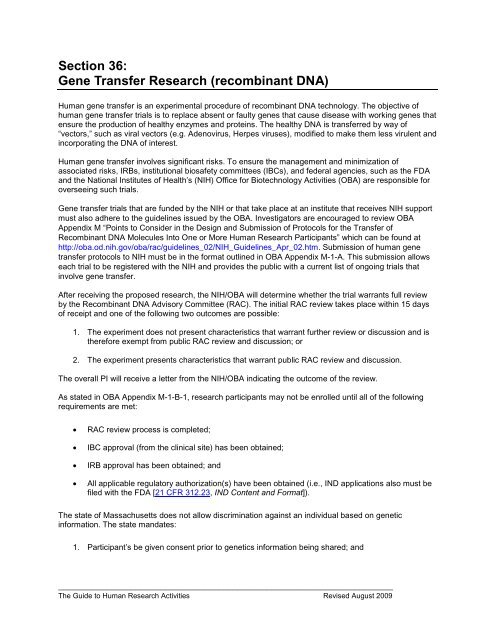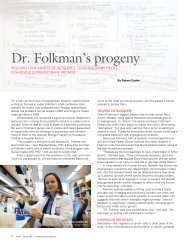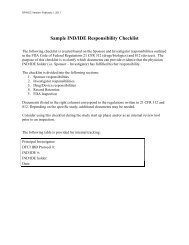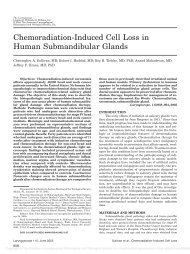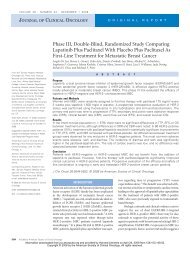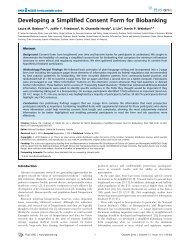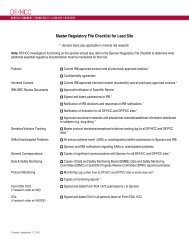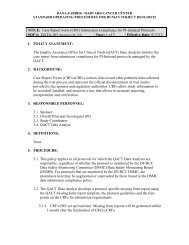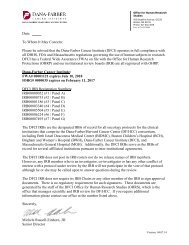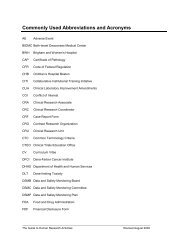Section 36: Gene Transfer Research (recombinant DNA)
Section 36: Gene Transfer Research (recombinant DNA)
Section 36: Gene Transfer Research (recombinant DNA)
Create successful ePaper yourself
Turn your PDF publications into a flip-book with our unique Google optimized e-Paper software.
<strong>Section</strong> <strong>36</strong>:<br />
<strong>Gene</strong> <strong>Transfer</strong> <strong>Research</strong> (<strong>recombinant</strong> <strong>DNA</strong>)<br />
Human gene transfer is an experimental procedure of <strong>recombinant</strong> <strong>DNA</strong> technology. The objective of<br />
human gene transfer trials is to replace absent or faulty genes that cause disease with working genes that<br />
ensure the production of healthy enzymes and proteins. The healthy <strong>DNA</strong> is transferred by way of<br />
“vectors,” such as viral vectors (e.g. Adenovirus, Herpes viruses), modified to make them less virulent and<br />
incorporating the <strong>DNA</strong> of interest.<br />
Human gene transfer involves significant risks. To ensure the management and minimization of<br />
associated risks, IRBs, institutional biosafety committees (IBCs), and federal agencies, such as the FDA<br />
and the National Institutes of Health’s (NIH) Office for Biotechnology Activities (OBA) are responsible for<br />
overseeing such trials.<br />
<strong>Gene</strong> transfer trials that are funded by the NIH or that take place at an institute that receives NIH support<br />
must also adhere to the guidelines issued by the OBA. Investigators are encouraged to review OBA<br />
Appendix M “Points to Consider in the Design and Submission of Protocols for the <strong>Transfer</strong> of<br />
Recombinant <strong>DNA</strong> Molecules Into One or More Human <strong>Research</strong> Participants” which can be found at<br />
http://oba.od.nih.gov/oba/rac/guidelines_02/NIH_Guidelines_Apr_02.htm. Submission of human gene<br />
transfer protocols to NIH must be in the format outlined in OBA Appendix M-1-A. This submission allows<br />
each trial to be registered with the NIH and provides the public with a current list of ongoing trials that<br />
involve gene transfer.<br />
After receiving the proposed research, the NIH/OBA will determine whether the trial warrants full review<br />
by the Recombinant <strong>DNA</strong> Advisory Committee (RAC). The initial RAC review takes place within 15 days<br />
of receipt and one of the following two outcomes are possible:<br />
1. The experiment does not present characteristics that warrant further review or discussion and is<br />
therefore exempt from public RAC review and discussion; or<br />
2. The experiment presents characteristics that warrant public RAC review and discussion.<br />
The overall PI will receive a letter from the NIH/OBA indicating the outcome of the review.<br />
As stated in OBA Appendix M-1-B-1, research participants may not be enrolled until all of the following<br />
requirements are met:<br />
<br />
<br />
<br />
<br />
RAC review process is completed;<br />
IBC approval (from the clinical site) has been obtained;<br />
IRB approval has been obtained; and<br />
All applicable regulatory authorization(s) have been obtained (i.e., IND applications also must be<br />
filed with the FDA [21 CFR 312.23, IND Content and Format]).<br />
The state of Massachusetts does not allow discrimination against an individual based on genetic<br />
information. The state mandates:<br />
1. Participant’s be given consent prior to genetics information being shared; and<br />
_____________________________________________________________________<br />
The Guide to Human <strong>Research</strong> Activities Revised August 2009
2. The results cannot be disclosed to any person without the participant’s prior written consent.<br />
In the following cases, a waiver of consent will be considered by the IRB where the results will be used<br />
only as confidential research information for the purpose of:<br />
1. <strong>Gene</strong>rating scientific knowledge about genes; or<br />
2. Learning about the genetic bases of disease; or<br />
3. Developing pharmaceutical or other treatments of disease<br />
Serious and unexpected adverse events experienced by participants enrolled in gene therapy trials must<br />
be reported to the IRB, IBC, OBA, and other federal agencies, if applicable. For further instructions, see<br />
the chapter entitled “Serious Adverse Event (SAE) Reporting Policy.”<br />
_____________________________________________________________________<br />
The Guide to Human <strong>Research</strong> Activities Revised August 2009


